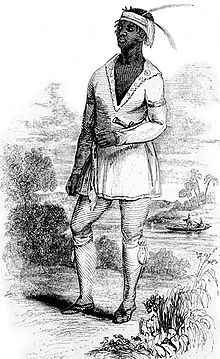Black Seminoles
Under the Black Seminoles (ger .: Black Seminoles ) can be understood from the plantations in Georgia and South Carolina to Florida in the tribal areas of the Seminoles escaped slaves of African origin and their descendants.
history
Most of the escaped slaves are said to have belonged to the Gullah language group before fleeing to Florida . Some black Africans also "acquired" the Seminoles from the Spanish and British.
After fleeing to the Indians, independent settlements of the black Seminoles developed from the late 18th century onwards with a vassal-like relationship to the Seminoles (taxes to the villages of the Indian Seminoles and in return protection by the Indians). Upon their arrival, they received tools and seeds for their villages. Their society was built up similar to that of the Native American Seminoles. The leadership of the loose tribe was a mixture of the black and Indian Seminoles. In agriculture, they mainly grew rice and grain and adopted Indian clothing. The Seminoles took over the cultivation of rice and the music of the black Seminoles. After a while, there were also marriages between black and Indian Seminoles and thus mixed villages.
The acceptance of blacks by the Seminoles was viewed critically by the white settlers and feared that further attempts to escape could be made by black slaves. Andrew Jackson took the admission of blacks by the Indian Seminoles as the reason for the invasion of Florida in 1817. In the course of the two Seminole Wars (1817 to 1818 and 1835 to 1842), where the black Seminoles fought together with the Indians, some black Seminoles fled the Bahamas . During the Second Seminole War , with the help of the black Seminoles, there were several uprisings by the black slaves on the plantations in Florida and the slaves overflowed to the Seminoles.
After the Second Seminole War, most of them were deported along with the Indian Seminoles to Indian territory , today's Oklahoma ( Path of Tears ). There they lived partly again in a state of slavery due to the white settlers and the supervision of the also slavery Creek .
Today Black Seminoles live mainly in Oklahoma, but also in Texas , the Bahamas and Mexico (near Coahuila ). Languages are predominantly English and Spanish , but also African-Seminolisches Creole ( Afro-Seminole Creole ) and Muskogee .
"Black Seminoles" is a modern term. What these people called themselves is not known. In Mexico they call themselves Indios Mascogos , in Texas as Seminoles and in Oklahoma as Freedmen (English for Liberated People ).
The Seminole Negro Indian Scouts also became known as scouts , who were in service with the US Army from 1870 to 1914.
memory
- Fort Mose Historic State Park in Florida is a National Historic Landmark on the site of the first free black community in the United States
- Four black Seminoles were awarded the Medal of Honor .
- A large sign in Bill Baggs Cape Florida State Park commemorates the site from which hundreds of former slaves fled to the Bahamas in the early 1820s
- Red Bays , Andros , the historic settlement in the Bahamas, and Nacimiento , Mexico are recognized as internationally recognized sites on the Network to Freedom Trail .
See also
Web links
- Rebellion: John Horse and the Black Seminoles, First Black Rebels to Beat American Slavery (English)
Individual evidence
- ↑ a b c d Joseph A. Opala, The Gullah: Rice, Slavery, and the American-Sierra Leone-Connection ( Memento of the original from August 29, 2009 in the Internet Archive ) Info: The archive link was inserted automatically and has not yet been checked. Please check the original and archive link according to the instructions and then remove this notice.
- ↑ a b c The USF Africana Heritage Project: Black Seminoles, Maroons and Freedom Seekers in Florida, Part 1 . www.africanaheritage.com. Archived from the original on January 1, 2013. Info: The archive link was inserted automatically and has not yet been checked. Please check the original and archive link according to the instructions and then remove this notice. Retrieved June 24, 2010.
- ↑ Howard Zinn: A People's History of the United States, Harper Perennial, 2005, p. 129 ISBN 0-06-083865-5
-
^ Bird, "The Largest Slave Rebellion in US History," Brown, Race Relations in Territorial Florida , 304; Rivers, Slavery in Florida , 203.
- ↑ FAQ on the Black Seminoles, John Horse, and Rebellion . www.johnhorse.com. Retrieved June 24, 2010.


